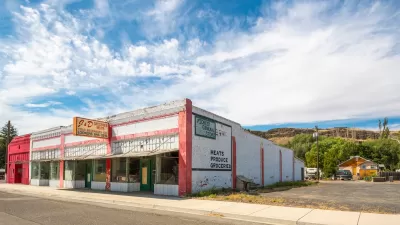With suburban markets saturated, discount food chains are moving into urban food deserts. While this may be convenient for residents, some are concerned that such stores will do little for local economies.
For 15 years, Oakland's inner city has been a food desert, with residents needing to travel great distances for groceries. Now city council is amending its eminent domain laws to potentially force a landowner to sell to the Kroger corporation so that a Foods Co discount supermarket/gas station can be built. Eric Holt Giminez of the Food First/Institute for Food and Development Policy is concerned that...
"[t]he corporate drive into the America's urban food deserts is reflective of the nation's food and financial crises. Large agrifoods corporations reaped windfall profits during the 2008 food crisis. Now these must be reinvested. Unfortunately, with the financial crisis, consumers are cutting back on purchases. Big retail must expand, but they have already saturated rural and suburban markets. The only place left is the urban market.
The problem of America's food deserts is complex and demands diversified, local solutions. The food system is better off with many stores--including large retailers--because they will help distribute risk, wealth and opportunities. This builds in economic resilience and food security."
FULL STORY: King of the Food Deserts

Planetizen Federal Action Tracker
A weekly monitor of how Trump’s orders and actions are impacting planners and planning in America.

Restaurant Patios Were a Pandemic Win — Why Were They so Hard to Keep?
Social distancing requirements and changes in travel patterns prompted cities to pilot new uses for street and sidewalk space. Then it got complicated.

Map: Where Senate Republicans Want to Sell Your Public Lands
For public land advocates, the Senate Republicans’ proposal to sell millions of acres of public land in the West is “the biggest fight of their careers.”

Maui's Vacation Rental Debate Turns Ugly
Verbal attacks, misinformation campaigns and fistfights plague a high-stakes debate to convert thousands of vacation rentals into long-term housing.

San Francisco Suspends Traffic Calming Amidst Record Deaths
Citing “a challenging fiscal landscape,” the city will cease the program on the heels of 42 traffic deaths, including 24 pedestrians.

California Homeless Arrests, Citations Spike After Ruling
An investigation reveals that anti-homeless actions increased up to 500% after Grants Pass v. Johnson — even in cities claiming no policy change.
Urban Design for Planners 1: Software Tools
This six-course series explores essential urban design concepts using open source software and equips planners with the tools they need to participate fully in the urban design process.
Planning for Universal Design
Learn the tools for implementing Universal Design in planning regulations.
Heyer Gruel & Associates PA
JM Goldson LLC
Custer County Colorado
City of Camden Redevelopment Agency
City of Astoria
Transportation Research & Education Center (TREC) at Portland State University
Camden Redevelopment Agency
City of Claremont
Municipality of Princeton (NJ)





























